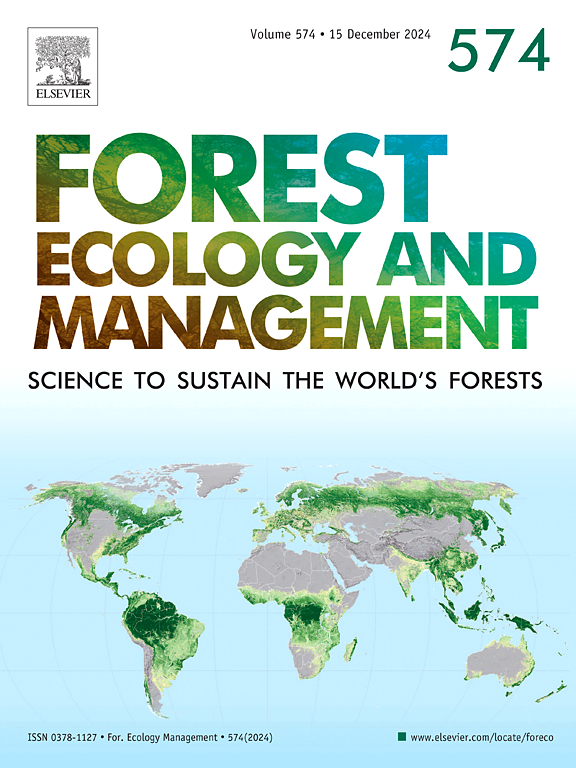Tree crowns broken off by windstorms are an unstable life raft for Collembola
IF 3.7
2区 农林科学
Q1 FORESTRY
引用次数: 0
Abstract
There are a number of ways to clear the aftermath of a windthrow disturbance of forest stands, the most common practice being to remove all broken trees and broken-off crowns lying on the ground. This practice leads to complete exposure of the soil, which deprives soil invertebrates (including Collembola) of the protection of trees that affords them a chance of surviving. Accordingly, following a windthrow disturbance of pine stands in 2017, a three-year study of collembolan assemblages was undertaken in stands spared from salvage logging. We aimed to test the effect of three different levels of disturbance (severely, moderately and least disturbed stands with a canopy cover of 0–20 %, 20–60 % and 60–90 %, respectively) on the survival of Collembola assemblages and to determine its association with changes in the soil environment and in the LAI index. Additionally, in the severely and moderately disturbed stands, Collembola were sampled between crowns of fallen trees and under the crowns. There were no significant differences in density, species richness and proportions of individuals of belowground “soil” and aboveground “epedaphic” species between the Collembolan assemblages that were associated with the degree of windthrow disturbance and time since disturbance. The study confirmed the presence of a significantly higher number of species and proportion of “epedaphic” species, and a lower proportion of “soil” species in the assemblages sampled under fallen tree crowns than between crowns. Analysis of principal response curves (PRC) yielded unexpected results as it indicated that these differences were significant only in the first year post-disturbance, thus suggesting a very short-lasting protective effect of tree crowns on Collembola, RDA analysis with preselected factors from environmental variables of interest (LAI of standing and fallen tree crowns, soil respiration, soil temperature and humidity, soil pH and soil nitrogen and carbon content) indicated the LAI index as significant for the Collembolan assemblages in the first yearpost-disturbance, soil moisture in the second year, and soil temperature in the third year. This sequence of significant indices over a three year period is compatible with the fallen crowns becoming more and more thinned as a result of needles falling off (from shade to full exposure to sunlight). We nevertheless postulate that at least some trees or their crowns lying on the ground should be left in place during clearance of windthrow-affected tree stands to facilitate restoration of the soil biota.
被暴风刮断的树冠是鞘翅目昆虫不稳定的救生筏
清除林分被风吹动后的残留物有多种方法,最常见的方法是清除所有折断的树木和地面上折断的树冠。这种做法会导致土壤完全裸露,使土壤中的无脊椎动物(包括齿孔虫)失去树木的保护,从而失去生存的机会。因此,在 2017 年对松树林进行风伐干扰后,我们对未受抢救性采伐影响的林分中的鞘翅目无脊椎动物群进行了为期三年的研究。我们的目的是测试三种不同程度的干扰(严重干扰、中度干扰和最少干扰林分,树冠覆盖率分别为 0-20%、20-60% 和 60-90%)对鞘翅目昆虫群落存活的影响,并确定其与土壤环境和 LAI 指数变化的关系。此外,在受到严重和中度干扰的林分中,还在倒伏树木的树冠间和树冠下采集了鞘翅目昆虫样本。鞘翅目昆虫群落的密度、物种丰富度以及地下 "土壤 "物种和地上 "表生 "物种的个体比例均无明显差异,而这些差异与风刮扰动程度和扰动后的时间有关。研究证实,与树冠之间相比,在倒伏树冠下采样的群落中,"表生 "物种的数量和比例明显较高,而 "土壤 "物种的比例较低。主响应曲线(PRC)分析的结果出乎意料,因为它表明这些差异仅在干扰后的第一年才显著,因此表明树冠对鞘翅目昆虫的保护作用非常短暂、土壤呼吸作用、土壤温度和湿度、土壤 pH 值、土壤氮和碳含量)进行的 RDA 分析表明,在受干扰后的第一年,LAI 指数对鞘翅目昆虫群落的影响显著;第二年,土壤湿度对鞘翅目昆虫群落的影响显著;第三年,土壤温度对鞘翅目昆虫群落的影响显著。在三年时间里,这一连串的重要指数与针叶脱落(从遮荫到完全暴露在阳光下)导致倒伏树冠变得越来越稀疏的情况相吻合。不过,我们认为,在清理受风倒影响的树丛时,至少应保留一些树木或其树冠,以促进土壤生物区系的恢复。
本文章由计算机程序翻译,如有差异,请以英文原文为准。
求助全文
约1分钟内获得全文
求助全文
来源期刊

Forest Ecology and Management
农林科学-林学
CiteScore
7.50
自引率
10.80%
发文量
665
审稿时长
39 days
期刊介绍:
Forest Ecology and Management publishes scientific articles linking forest ecology with forest management, focusing on the application of biological, ecological and social knowledge to the management and conservation of plantations and natural forests. The scope of the journal includes all forest ecosystems of the world.
A peer-review process ensures the quality and international interest of the manuscripts accepted for publication. The journal encourages communication between scientists in disparate fields who share a common interest in ecology and forest management, bridging the gap between research workers and forest managers.
We encourage submission of papers that will have the strongest interest and value to the Journal''s international readership. Some key features of papers with strong interest include:
1. Clear connections between the ecology and management of forests;
2. Novel ideas or approaches to important challenges in forest ecology and management;
3. Studies that address a population of interest beyond the scale of single research sites, Three key points in the design of forest experiments, Forest Ecology and Management 255 (2008) 2022-2023);
4. Review Articles on timely, important topics. Authors are welcome to contact one of the editors to discuss the suitability of a potential review manuscript.
The Journal encourages proposals for special issues examining important areas of forest ecology and management. Potential guest editors should contact any of the Editors to begin discussions about topics, potential papers, and other details.
 求助内容:
求助内容: 应助结果提醒方式:
应助结果提醒方式:


